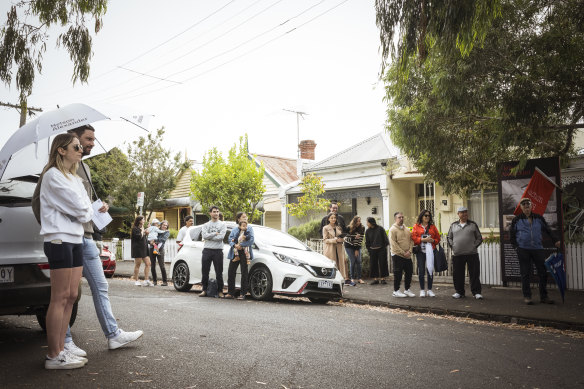This was published 1 year ago
The Melbourne suburbs where home owners can’t afford their mortgages
At least one in 30 households in a string of outer Melbourne suburbs and the investor-heavy CBD have fallen behind on their mortgage repayments.
Five per cent of home loans in postcode 3000 and more than 4 per cent in Albanvale and Calder Park in the west are at least 30 days in arrears, Moody’s Ratings warns, as owners are hit hard by higher interest rates and the rising cost of living.
At least 3 per cent of loans are in arrears in Kurunjang, Craigieburn, Bangholme, Bacchus Marsh and Noble Park.
Melbourne’s north west and west overall had higher delinquency rates as of November 2023 than more affluent areas such as the inner east and inner south, the Moody’s report found.
The share of households falling behind on their mortgages is rising around the country and tipped to increase this year as households buckle under pressure, but the impact is uneven.
Borrowers in outer suburbs tend to have lower incomes and less disposable income than those in the inner suburbs, Moody’s Ratings vice president and senior credit officer Alena Chen said.
Outer suburbs have less diverse job markets, and if a region has many workers in risky industries such as construction, there can be concentrated job losses that affect borrowers’ ability to make repayments, she said.
“That same magnitude of increase in interest rates would be a bigger burden on borrowers who have less buffer from other savings or accrued wealth,” she said.
The Melbourne suburbs where home owners are most likely to be keeping up with their repayments are largely scattered across the city’s east, ranging from Ferntree Gully and Blackburn to Hughesdale, Bentleigh and Bentleigh East.
Chen also said timing was a factor in whether borrowers were likely to fall behind.
Loans that were approved during 2021 and 2022 are deteriorating more than loans approved in other years, she said, given interest rates were historically low and house prices were peaking, meaning borrowers needed to take out larger loans because housing was so expensive.
Chen said investment loans had not yet worsened because many investors are still on interest-only repayments, but warned this could change.
“For the first three years of interest-only payments, compared to a principal and interest loan, that borrower has not been reducing the loan amount, so once you step up the interest it will be a much bigger shock,” she said.
She warned arrears rates are likely to rise moderately this year, although a strong labour market and solid housing market would limit the impact.

Home owners are under pressure from rising interest rates and inflation.Credit: Chris Hopkins
Mortgage broker Nariman Amalsadiwala has clients who are finding it tough to meet their repayments, but managing so far.
Some are trying to consolidate debts such as car loans and credit cards, but not all are able to because of limits on their borrowing capacity, the Red Maple Finance director said.
“Luckily I don’t have any clients who have seen a default,” he said. “In terms of people struggling to keep it up, yes definitely, I hear it a lot of times.”
He said owners who borrowed in the last three to four years while interest rates were low are facing the most stress now that the Reserve Bank has hiked the cash rate to 4.35 per cent to tame inflation.
Some are revising their budgets or have to sell an investment property, while he is reviewing client loans to try to secure better deals with the same lender or by refinancing. One tried to convert their owner-occupier loan to interest only, which can be a challenging process.
“Downsizing their living budgets and that sort of stuff is what I hear a lot,” he said.
AMP deputy chief economist Diana Mousina said mortgage arrears overall have risen to pre-COVID levels, but are not anywhere near high enough to pose a risk to the stability of the financial system.
“The households you’re most worried about are the ones that have little free cash flow after they pay for all their essential items,” she said.
Households that have taken out large loans or borrowed in the last few years are at higher risk, as are workers who lose their jobs as the unemployment rate rises.
She said the outer suburbs were likely overrepresented in the arrears data given residents’ more modest incomes. Buyers in the inner suburbs are more likely to be purchasing more expensive properties.
As for any relief from an interest rate cut, AMP said it is unlikely until November, and Mousina said it may be longer.
“Interest rates are likely to stay quite elevated, which will prove to be tough for the home owner.”